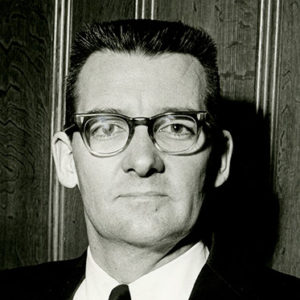calsfoundation@cals.org
Accomplices to the Crime
Accomplices to the Crime is penologist Thomas O. Murton’s 1969 nonfiction account of his efforts to reform the Arkansas prisons during the administration of Governor Winthrop Rockefeller. The book provides a graphic description of the brutality and corruption at Tucker Unit in Jefferson County, where Murton spent most of his time as a prison manager. The book also examines Murton’s brief but controversial tenure at Cummins Unit in Lincoln County. The book, written by Murton and Hollywood writer Joe Hyams, sold well and became the basis for the 1980 film Brubaker, starring Robert Redford. Some of the claims Murton made in the book, however, were later challenged.
The book begins with the Murton arriving in Arkansas, where he was responsible for reforming Tucker prison farm. Murton was teaching at Southern Illinois University and working on a doctoral degree in criminology when Rockefeller, who wanted an outsider to help reform the state’s prison system, called him for help. In the early pages of his book, Murton, who had experience working in Alaska’s prison system, recalls the “dreary” drive south from Little Rock (Pulaski County) to Tucker prison in February 1967. Tucker was the smaller of the two main prison units in Arkansas and housed white convicts (though it also housed African Americans on death row).
Murton provides details of the shocking conditions at Tucker, evoking comparisons to the slave plantations of the Old South. Murton’s predecessor, Jim Bruton, had been accused of systematic corruption and brutality, including the torture of inmates with the Tucker Telephone. In the book, Murton explains that he abolished the use of the leather strap, which was still in use despite it having been outlawed years before. He also took more basic measures to make the prison better by improving sanitation (the book contains a memo in which Murton asks inmates not to defecate on the floor), raising the quality of meals, making an effort to stop rapes, and providing more open communication between himself and the prisoners. He even started a prison musical band.
The book outlines Murton’s straight-forward approach. He wore denim jeans and a work shirts rather than dressing more formally. He spoke to prisoners honestly and sought their feedback on how to better manage other inmates. “You can never lie to an inmate,” Murton says. Accomplices takes a grim look at Arkansas’s prison system, but it also contains black humor, as in the passages where Murton enlists the help of “Chainsaw” Jack, a convicted murder, to help crack down on homosexual activities at Tucker.
As the book shows, these unorthodox methods drew both publicity and criticism. When Murton arranged a dance for inmates, for example, the decision drew fire from those who thought he was treating prisoners too lightly. In addition to Murton’s denunciations of conditions at Cummins and Tucker, his book explores the woefully inadequate women’s prison, located on the same grounds as Cummins. The women’s reformatory was small, but it contained mostly non-violent offenders, including a woman incarcerated for a drinking problem. One activity for the women involved cutting grass with scissors in the prison yard. In Accomplices, Murton agrees with penologist Austin McCormick’s assessment of the women’s prison: a more neglected set of inmates could not be found in the United States.
The latter part of the book concerns Murton’s fateful transfer to Cummins, a prison much larger than Tucker that Murton describes as a “fort under siege.” Murton, nevertheless, was prepared to continue implementing reforms. At Tucker, Murton had looked for bodies buried at the grounds but had found none. At Cummins, an inmate informant told him there were as many as 200 skeletons buried not far from the barracks. Murton wanted the remains exhumed.
His decision to exhume skeletons in late January 1968 proved his undoing as a prison superintendent. Murton believed the skeletons he unearthed were those of murdered men, and he wanted further digging and investigation. In the face of public criticism, Governor Rockefeller blocked any more excavations pending an investigation. In Accomplices, Murton calls the Arkansas State Police’s report on the skeletons a “fraud” and refuses to back down on his claims. “True reform is an intolerable irritant to the Establishment,” he concludes. (Significantly, a later report from a forensic anthropologist indicated that the graves were those of an abandoned pauper cemetery on the prison campus.) Rockefeller criticized the investigation report as well, but the prison board fired Murton. In Accomplices, Murton criticizes Rockefeller for his “vindictiveness,” lack of courage, and propensity for drink.
Murton began work on his book manuscript before he had even left the penitentiary. Murton showed himself to be a capable and wry writer, but his publisher, the New York–based Grove Press, enlisted the help of Joe Hyams to co-author the book. Hyams, who did not witness events in Arkansas firsthand, had an impressive track record as a Hollywood writer who was known as the “journalist to the stars.”
Murton’s experience and dry sense of humor, combined with Hyams’s flair for the dramatic, impressed some readers of Accomplices to the Crime. Kirkus Review called it a “powerful document with serious implications.” People in the corrections field, however, were more critical. Paul W. Keve of the Minnesota Department of Corrections agreed Murton’s story was important but asserted Accomplices was “written by the wrong person.” He called Murton “abrasive” and his reform tactics “ill-timed.” Murton responded to his critics in his usual forceful style.
Accomplices to the Crime sold well at the time of its release but went out of print. Hard copies of the book have become collector’s items. Murton published other books, and Accomplices was reissued as Inside Prison USA in 1972. Murton’s work became the basis for the 1980 film Brubaker. Murton made no money from the film, but the movie was a financial success. Murton died in 1990; Hyams died in 2008.
For additional information:
Book Reviews. Crime and Delinquency 16 (October 1, 1970): 442–453.
Jackson, Bruce. Killing Time: Life inside the Arkansas Penitentiary. Ithaca, NY: Cornell University Press, 1977.
McClellan, Dennis. “Joe Hyams Dies at 85; Former Hollywood Columnist, Bestselling Author.” Los Angeles Times, November 12, 2008. Online at http://www.latimes.com/local/obituaries/la-me-hyams12-2008nov12-story.html (accessed August 9, 2017).
Murton, Tom, and Joseph Hyams. Accomplices to the Crime: The Arkansas Prison Scandal. New York: Grove Press, 1969.
Colin Edward Woodward
Lee Family Digital Archive, Stratford Hall
 Divergent Prosperity and the Arc of Reform, 1968–2022
Divergent Prosperity and the Arc of Reform, 1968–2022 Law
Law Literature and Authors
Literature and Authors Ruled by the Whip
Ruled by the Whip Thomas Murton
Thomas Murton 




Comments
No comments on this entry yet.